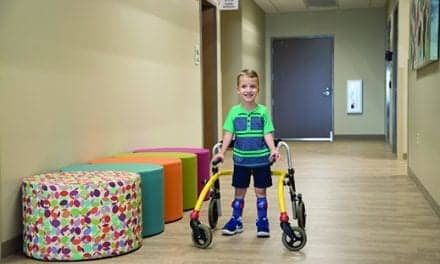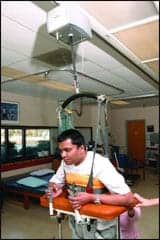
A home evaluation by an occupational therapist can help construct a home that is accessible for people with disabilities and older individuals. The height of sinks and counters should be about 36 inches off the floor.
The population in our country will age rapidly during the next 20 years. By 2030, one in five Americans will be age 65 or older. The concept of aging in place is becoming the preferred choice among this group: People want to continue living in their homes as they grow older. But aging in place requires a plan to meet changing physical needs. Addressing accessibility issues and adapting the home to meet physical challenges—long the concerns of individuals with permanent disabilities—are central to the notion of aging in place.
As an occupational therapist, evaluating the home environment to meet the physical needs of patients has long been a part of my work. That kind of evaluation is now in demand among the aging population as well as for my patients at Good Shepherd Rehabilitation Hospital in Allentown, Pa. In November 2009, I obtained a new certification to complement my existing certifications as an occupational therapist, a certified driving rehabilitation specialist and an assistive technology practitioner. Through a training program offered by the National Association of Home Builders, I became a certified aging in place specialist. The certification is also available to home builders and contractors.
The process for determining the needs for aging in place is similar to the evaluations that I complete for my patients at the rehabilitation hospital. In doing a home modification assessment, I consider the physical challenges faced by an individual and identify areas in the home that must be changed to accommodate the person’s needs. The first step is to go into a home and observe a person in his environment. I watch his daily routine. I may watch how they get in and out of the shower, on and off the toilet, or reach the stove. I have even asked patients to cook an egg while I watch so that I can see which drawers they open, which knob they turn on the stove, and so on. These observations help me to make recommendations about the changes necessary for ease of use and safety in the home. Grab bars may need to be installed for the shower. A stove with knobs in the front may be needed to cook safely if a person is in a wheelchair. Most of the time the focus of my work has been on modifying what exists to meet a person’s existing needs.
When planning for aging in place, a house is built or remodeled with an eye on what physical challenges could develop instead of examining what already exists. The process is almost like anticipating a worst-case scenario. Preliminary work is done so that anything that may happen—from mobility issues to loss of sight—can be accommodated later on. The groundwork is laid for multiple conditions that may or may not become reality.
PLANNING A NEW HOME
People who want to age in place have an opportunity to plan ahead for needs that may arise 10, 15, or even 20 years in the future. Just as they may have planned ahead for their children’s college educations, many people are now planning for a home that adapts to their changing needs as they age. This is especially easy to accomplish if a new home is being built.
The criteria for building both residential and commercial structures changed with the passage of the Americans with Disabilities Act. Many of the minimum requirements for new construction implemented with the ADA have made it easier to plan for aging in place. New construction already meets parameters that make it easier to adapt the living space. Some examples of the criteria typical in new construction, as dictated by the ADA, include:

An occupational therapist will consider the physical challenges faced by an individual within a home and will make recommendations to accommodate those needs.
- Sidewalks: The minimum width for an ADA-compliant sidewalk is 3 feet, or 36 inches. This will allow easy wheelchair or walker access.
- Door openings: The minimum required width is 32 inches.
- Turning space in a bathroom for a wheelchair is 60 inches in diameter.
- Light switches and electrical outlets are now set at heights that are mandated for accessibility by someone in a wheelchair.
- Shower stalls are built with reinforced walls, allowing for the secure installation of grab bars.
- Lever door handles and faucets instead of traditional doorknobs and handles on sinks are used. These can be manipulated with a fist, if necessary.
- The height of countertops should be approximately 36 inches off the floor.
These are just some of the parameters that now are automatically met in new home construction. They already set the stage for a home that will allow its owners to age in place. There are many additional features in a new home that, while not mandated, will provide the flexibility for physical challenges that may emerge later.
For example, posi-temp valves, which regulate water temperature fluctuations on faucets, will help prevent burns for someone who is a paraplegic or quadriplegic and has impaired sensation. They can easily be included even though they are not mandated. Handheld showers provide flexibility for people who may have to be seated in the shower during later years. Bathroom sinks can be built with a mock cabinet underneath instead of the traditional vanity, so that it can be removed for wheelchair or walker accessibility. Rocker switches rather than toggle switches for lights are easier to manipulate. When choosing floor coverings, hardwood floors, ceramic tile, or Pergo is preferable to carpeting. They provide a smooth surface for wheelchairs and walkers.
In the kitchen, a wall oven that is built at a comfortable height will be easier to access than one built into a stove. Many individuals have difficulty maneuvering a wheelchair close enough when the oven door is open, making it especially challenging to handle hot pans.
When considering the overall floor plan for a new home, barrier-free design with few or no doorways for common living areas allows for the most flexibility. When aging homeowners suddenly find themselves in a walker or wheelchair, this open concept makes navigating within the home easier and safer. Doorways with minimal thresholds or none at all make ingress and egress easier.
ADAPTING AN EXISTING SPACE
Adapting an existing dwelling poses more challenges. Much of my work as an occupational therapist involves assessing a patient’s existing home and recommending changes that will make it both safe and accessible. Those recommendations also would answer the concerns of someone who wishes to make an existing home suitable as they age.
Some of the changes that I recommend are relatively simple, such as removing throw rugs so people won’t trip on them or eliminating extra furniture or clutter to make it easier to navigate in a walker or wheelchair. Sometimes structural changes are necessary to improve accessibility. Doorways may need to be widened in older homes to accommodate a wheelchair. Perhaps a ramp needs to be installed when many steps lead up to a front door.

The ADA says the turning space in a bathroom for a wheelchair is 60 inches in diameter.
A two-story home may pose challenges, but they are not insurmountable. One solution is to relocate a bedroom to the first floor. But for many this is not an option, since it involves converting a dining room or even part of the living room into a sleeping area. A stair glide provides another solution for individuals with some mobility, provided that the staircase meets minimum width requirements and includes 5 feet at the top of the stairs for transferring to a wheelchair or walker.
Installing grab bars should be a simple solution to help with balance issues in the shower or tub, but older homes may not have the reinforced walls in the shower stall to secure them. The bars must be installed by attaching them to existing studs. The solution often is to install them vertically so they can be firmly attached. Grab bars near the toilet also can be helpful. Rotator cuff injuries are among the most common for older individuals as they grasp a sink in front of them to pull themselves up from the toilet. Grab bars minimize this stress on the body.
WORKING WITH BUILDERS AND CONTRACTORS
An occupational therapist can be helpful in assessing what should be changed or adapted in a home when planning to age in place. Someone who is working with a builder or contractor on a new home or existing house should consider an assessment by an occupational therapist in addition to the recommendations that may be made by a builder. The opposite also is true. Many changes—such as lowering counters and relocating laundry facilities from a basement—require the input of a contractor or builder. Although such recommendations may be appropriate, there may be structural limitations that will prohibit making these changes. For example, moving a washing machine from the basement to an upstairs area may not be feasible because pipes cannot easily be relocated. I have learned that the input of a qualified contractor is important in determining what changes can realistically be made to a home. They can provide practical information about both feasibility and cost.
Planning ahead to age in place can have financial advantages. Changes to a home may be made while individuals are still working instead of after retirement, when income is more limited. Financing necessary changes to the home can be challenging in later years when health issues make such changes an immediate necessity. Insurance, including Medicare, does not cover remodeling and building fees, even when changes are medically necessary. Planning ahead for aging in place in these cases is sensible for economic reasons and to minimize changes to lifestyle later on.
Angela Brown, COTA/L, ATP, CDRS, CAPS, is an occupational therapist at Good Shepherd Rehabilitation Network in Allentown, Pa. Her job includes home evaluations for Good Shepherd’s Designs for Life Home Modification Program.





